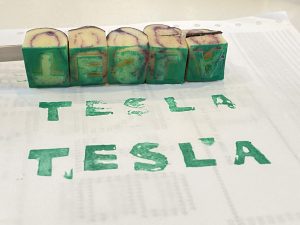
For this assignment, I stamped a five letter word by cutting my own typeface from small potatoes as a representation of the revolutionary shift that was the invention of movable type printing. I chose “Tesla” as my five letter word because my wife and I recently purchased an electric car and it’s something we’re very proud of.
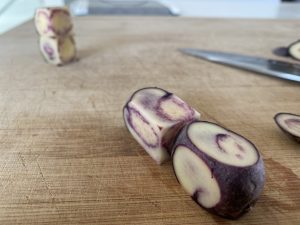
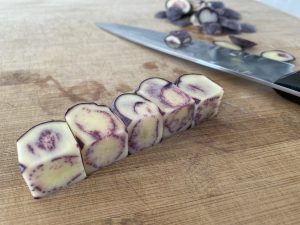
The intricacy of accurately carving a letter even a couple centimetres high was particularly challenging, not just because of the medium, but the fine motor control and knife skill involved. Also, carving the letter mirrored is necessary or else the print will be backward which requires constant attention. I am baffled by the skill and precision of Gutenberg as described by Clement (1997) in decreasing the font size to get his bible to have more lines and thus fewer pages.
It took me 20 minutes to make the stamps, but I planned ahead mentally, knowing that I would square the potatoes first into prisms, carve the letter mirrored, then skewer and stamp.
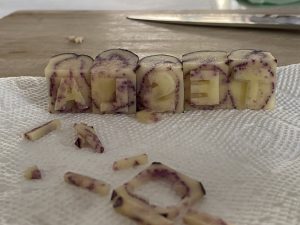
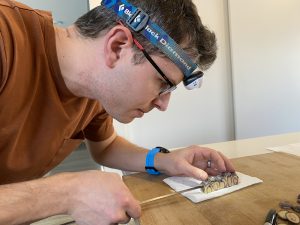
Rather than stamping individual letters one at a time, I attempted to secure my potato stamps by way of a skewer through the lot of them, similar to the way a compositor would have mounted the type in a “composing stick” (Clement, 1997. pp.14).
I noticed that not all Roman alphabet letters are equally difficult to carve: Straight letters like L and T were easiest, as I could use long parallel cuts to form them. Removing the interior pieces from the E and A was challenging, and the curvature of the S was the greatest difficulty.
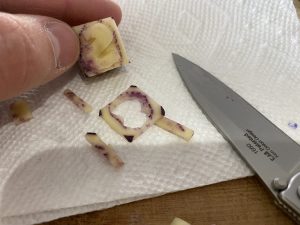
Considering the time and effort that took you to create a 5-letter word, my feelings on the mechanization of writing are as follows:
-
- I owe a debt of gratitude I can’t fully comprehend to Gutenburg. Our species would not be where it is now without widely distributed and accessible literacy. As Ong tells us of Einstein, science would not have been possible without writing and printing (Ong, 2002. pp.115).
- While printing is and was more efficient than scribing, typesetting was still a highly skilled and onerous task; the focus required to set error-free pages for long hours would have been gruelling (Harris, 2018).
- I have access to safe ink. Medieval pigments were expensive, hard to make, and sometimes toxic, containing mercury and/or lead (Clement, 1997. pp.12)
- Having access to printed books, and the internet, plus not having to spend my life copying a book by hand nor spending a fortune on one, I get to spend more time with my family. My daughter enjoyed helping me with this activity and even carved a letter of her own!
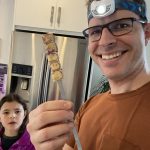
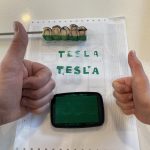
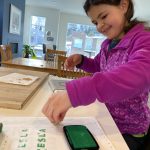
References
Clement, R. W. (1997). Medieval and Renaissance Book Production. Library Faculty & Staff Publications. Paper 10. https://digitalcommons.usu.edu/lib_pubs/10
Harris, B. (2018, February 4). The printed Book: Opening the floodgates of knowledge. [Audio podcast episode]. In How it Began: A History of the Modern World. Retrieved February 01, 2021, from https://howitbegan.com/episodes/the-printed-book/
Ong, W. J. (2002). Orality and Literacy: The Technologizing of the Word. Routledge. https://monoskop.org/images/d/db/Ong_Walter_J_Orality_and_Literacy_2nd_ed.pdf